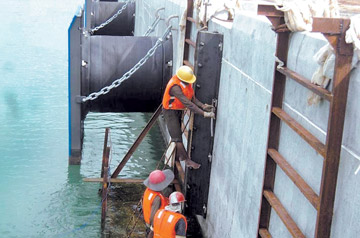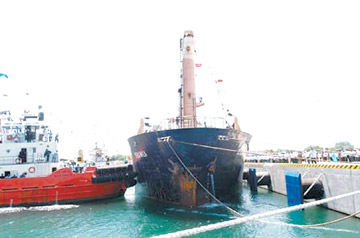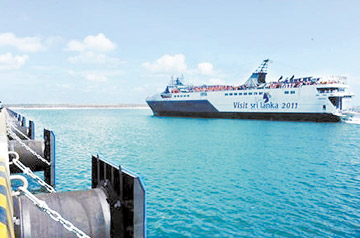Hambantota Port to make Lanka S Asian transshipment hub
By Shirajiv Sirimane
Investor confidence for the Ruhunu Magampura Mahinda Rajapaksa Port
is increasing with several global players and local investors wanting to
stamp their footprint there.
 |
| Operations at
the port |
 |
| Port view from
the sea bank |
 |
| Berth at
Magampura Port |
The Sri Lanka Ports Authority (SLPA) has an ambitious task to attract
billions of dollars worth of investments to the port and though the
Opposition is trying to make a mockery of the situation, the target is
very much within reach. Minister of Ports and Highways (Project) Rohitha
Abeygunawardana said the US$ 650 million investments by foreign
investors at the first stage of the port had further strengthened the
confidence of global industrial and commercial giants regarding the
success of this innovative project in southern Sri Lanka.
“The port in Hambantota is a major economic centre that has ensured
the ushering of socio-economic prosperity from the South to the whole of
Sri Lanka in the future,” he said.The SLPA has received many investment
proposals from prospective local and foreign investors to establish
businesses within the port premises. Out of the 27 proposals received,
the Cabinet has approved seven investment proposals, subsequent to the
recommendations by the Cabinet Appointed Negotiating Committee with the
assistance of a Technical Evaluation Committee.
These proposals include those for setting up a sugar refinery plant;
cement grinding/ bagging plant, fertiliser plant, petro-chemical plant
and warehouses. The proposal to establish a sugar refinery was made by
Shree Renuka Sugars Ltd, India which has formed a local subsidiary
company, Lanka Sugar Refinery Company (Private) Limited. The SLPA and
Lanka Sugar Refinery Company signed the Business Venture Agreement last
year and now companies from Pakistan and even Singapore have inked
agreements to set up ventures at Hambantota.
Thatta Cement Company (Pvt) Ltd, Pakistan will construct a cement
grinding and bagging plant and CEO and Vice Chairman of Thatta Cement
Karachi Muhammad Fazlullah Shariff told the Sunday Observer that this is
the first time that the company launches operations outside Pakistan.
He said while the global demand for cement is around three percent
annually, the Sri Lankan demand is around four percent.
Demand for cement
"However, we have noted that the demand for cement in the Hambantota
area is around eight percent and this was the main reason for us to set
up operations in Hambantota,” he said. He said when an international
airport and harbour are set up, a similar demand is witnessed.
The proposed plant will employ a closed circuit cement grinding mill
and cement and packing plant for cement manufacture and dispatch. The
total investment is estimated at US$ 15.15 million, to be incurred
during the first five years of operation.
At the commencement the minimum guaranteed production volume of the
plant will be 100,000 Mt/year which will increase gradually to 1,000,000
Mt/year at the end of the first decade. Thatta Cement Company (Pvt) Ltd
is the local subsidiary company of Thatta Cement, Pakistan.
He said the project would commence mid-2013 and operations are
expected to commence next year. “The project would generate 50 direct
employment opportunities.” The Business Venture Agreement with the SLPA
would be for 25 years. Land allocation for this business venture will be
four hectares. It will generate a minimum revenue of US$ 9.9 million
over the 25 years, via a land lease agreement. In addition, by royalty
payment, the SLPA will earn US$ 65.5 million over 25 years. The SLPA
will achieve more benefits via this project as it generates vessel
movements at the port. Since Thatta Cement is willing to employ more
than 150 Sri Lankans, the project would benefit our country from that
angle too.
In addition to this venture, McLarens Holdings Ltd (Warehousing),
Agalawatta Plantation PLC (Warehousing) and ACE Distripaks (Pvt) Ltd
(Warehousing) have expressed interest to commence business at the
Hambantota port zone. Micro Cars Limited too inked an agreement to set
up a vehicle assembly plan at the prot investment zone.
Second stage
Chairman, SLPA, Dr. Priyath Wickrama said the effective intervention
of President Mahinda Rajapaksa to lure the international community to
commence business in sustainably peaceful environs in the country has
brought about the dawn of an era of prosperity for all Sri Lankans.
“At the second stage of the investment process at the Hambantota
port, 11 more investors will arrive at the port with investments of
nearly US$ 1.1 billion, which would increase the total investment by
investors at the port to US$ 1.8 billion. The port in future will play a
key role in the Indian subcontinent to enrich the industries in the
region,” he said.
Hayleys PLC and Dragon Asia Fertiliser Limited of Hong Kong have
become the first private sector entities to invest in the Ruhunu
Magampura Mahinda Rajapaksa Port by committing US$ 7 million for an
international fertiliser storage, processing, bagging and distribution
hub.This landmark investment will result in the development of a local
and international fertiliser transshipment and distribution hub of over
200,000 square feet in extent, in an area of 2.5 hectares.
|

Sugar refining, another venture planned at the Hambantota Port |
Construction work on the facility, which received Cabinet approval in
August, began with the laying of the foundation stone on December 5,
2011, amidst a gathering of senior government officials and senior
representatives from Hayleys and Dragon Asia Fertiliser.
“This facility, which has the potential to generate significant
employment opportunities for Sri Lankans and to attract vessels to the
Hambantota Port, represents an important development in the
infrastructure expansion in the country,” Hayleys Group Chairman Mohan
Pandithage said.
“As a Group that has consistently supported development initiatives
in Sri Lanka, Hayleys is proud to take the initiative in investing in
the Ruhunu Magampura Port industrial zone, setting a precedent for other
private sector entities to follow,” he said.
Once operational, the state-of-the-art Hambantota International
Fertiliser Distribution Hub hopes to attract major fertiliser shipments
from the Baltic Sea region to the Port of Hambantota, by employing its
strategic location to deliver freight advantages to buyers in terms of
cost and time savings.
Such cost advantages will in turn benefit the local agriculture
industry, enabling the local farmers to thrive.
It is envisaged that these bulk fertiliser shipments which arrive at
the Hambantota port on larger mother vessels will also be distributed to
the Indian subcontinent and South East Asia on feeder vessels, the
company said.
Shree Renuka Sugars Limited India, through its subsidiary Lanka
Sugar(Pvt)Limited will invest US$ 220 million on a sugar refinery at the
Port. The project will provide direct employment to 300 and indirect
employment to 1,500 individuals.
Investment Promotion Minister Lakshman Yapa Abeywardena said that
many investors were willing to commence new factories at the Magampura
port and the construction of a port in Hambantota was an important
catalyst for major economic development in Sri Lanka.
In addition to attracting fertiliser shipments, the facility
developed by Hayleys and Dragon Asia Fertiliser is also expected to open
new markets such as Africa, which has the potential to be catered to,
via the Hambantota port.
Construction work
Meanwhile, the construction work of the second phase of the
Hambantota Magampura Port has begun and it is expected to cost around
US$ 800 million to complete the second phase of the project.
Magampura Port Chief Engineer Agil Hewageegana said, “Under this
project, a new terminal will be built in the Port area.
Accordingly, five more vessels can be accommodated in this terminal
apart from the current four vessels which can be accommodated in the
first phase of the port project.”Upon the completion of the construction
work in the second phase, the Port will cover around 150 hectares of
land and accommodate nine vessels at any given time.
“We will be looking at possibilities to start construction work of
the third phase of the project once the main requirements are
completed,” Hewageegana said.
The total construction cost of phase one was US$ 360 million of which
US$ 306 million was funded by the People’s Republic of China. According
to the port master plan, 33 vessels can be accommodated at the port at
any given time once construction work of all phases are completed. “The
second phase of the port will provide a strong supplementary port to the
Colombo Port and support Sri Lanka to consolidate its status as a
transshipment hub in the South Asian region,” he said.
Sri Lanka will start operations at the 82,000 ton capacity fuel
bunkering terminal of the port in October, 16 months later than the
original schedule, the Ports Authority said.The State-run SLPA had
originally planned to open the facility for full operational bunkering
in May 2011.The US$ 130 million project contains eight tanks of
bunkering oil and six tanks of aviation fuel and LPG in the initial
stage.
The aviation fuel stored in the Hambantota Port could be used for the
Mattala Airport, the second international airport of Sri Lanka. The
Hambantota bunkering capacity could be expanded to four million metric
tonnes if demand picks up.
Bunkering operation
The bunkering operation is the only part of the port not open to
external investment.China Exim Bank has loaned US$ 77 million toward the
cost of the terminal, which the Ports Authority will operate. China has
loaned Sri Lanka the bulk of the money to build the US$ 1.5 billion
port.
China will finance the expansion of the Hambantota Port and the first
phase too was financed by China. It has been positioned as an industrial
port with facilities to transship vehicles and also provide bunkering
services.
The Hambantota Port, which opened in November 2010, is set to be Sri
Lanka’s biggest port once the second phase is completed and to give the
Indian Ocean country access to traffic on one of the world’s biggest
East-West shipping lanes, located a few kilometres off its southern
coast. |


